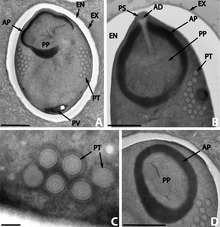| Nosema | |
|---|---|

| |
| Nosema podocotyloidis | |
| Scientific classification | |
| Domain: | Eukaryota |
| Phylum: | Microsporidia |
| Family: | Nosematidae |
| Genus: | Nosema Nägeli (1857) |
Nosema is a genus of microsporidian parasites. The genus, circumscribed by Swiss botanist Carl Nägeli in 1857, contains 81 species.[1] Most parasitise insects and other arthropods, and the best-known Nosema species parasitise honeybees, where they are considered a significant disease by beekeepers, often causing a colony to fail to thrive in the spring as they come out of their overwintering period. Eight species parasitize digeneans, a group of parasitic flatworms, and thus are hyperparasites, i.e., parasites of a parasite.[2]
- ^ Cite error: The named reference
Kirk2008was invoked but never defined (see the help page). - ^ Toguebaye, B. S., Quilichini, Y., Diagne, P. M. & Marchand, B. 2014: Ultrastructure and development of Nosema podocotyloidis n. sp. (Microsporidia), a hyperparasite of Podocotyloides magnatestis (Trematoda), a parasite of Parapristipoma octolineatum (Teleostei). Parasite, 21, 44. doi:10.1051/parasite/2014044 PMID 25174849
